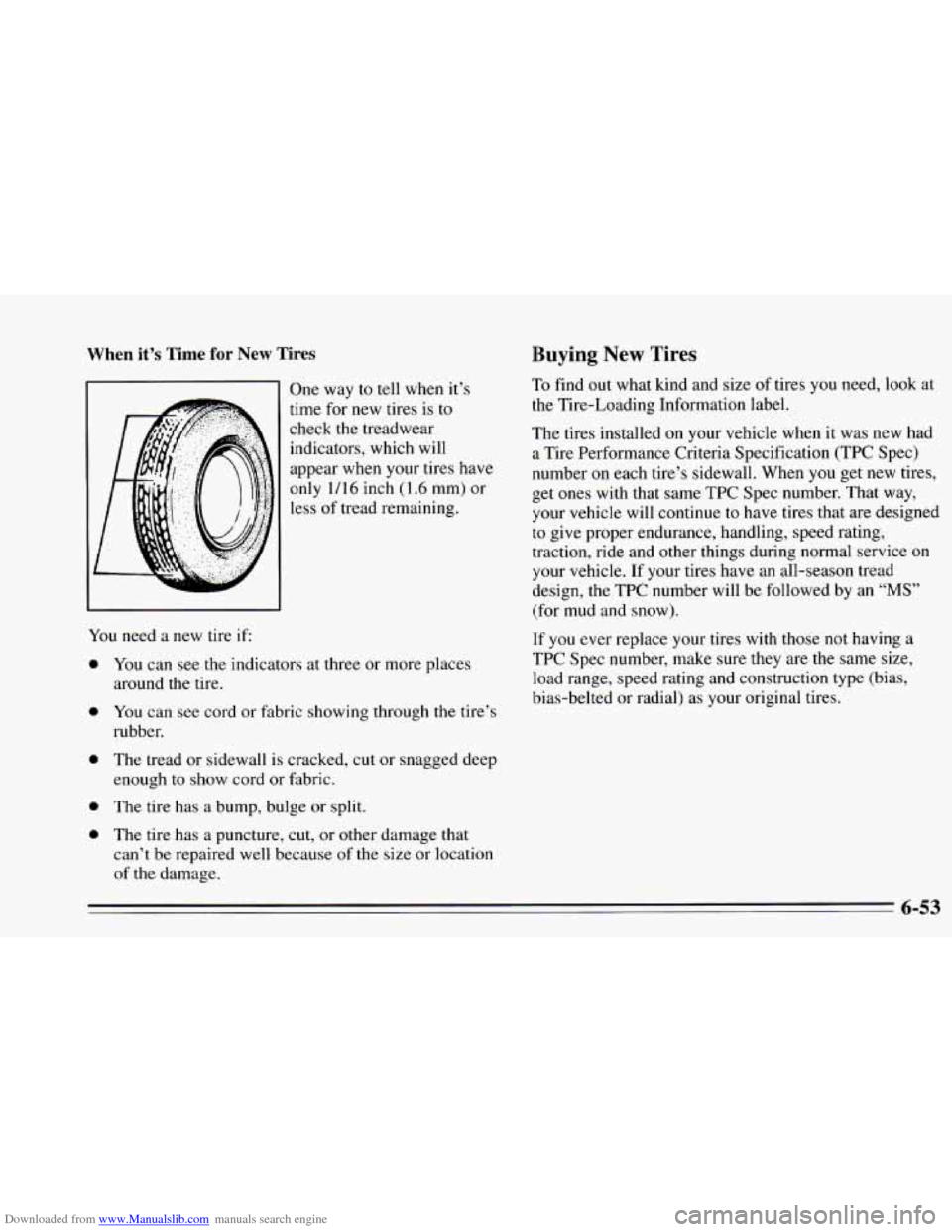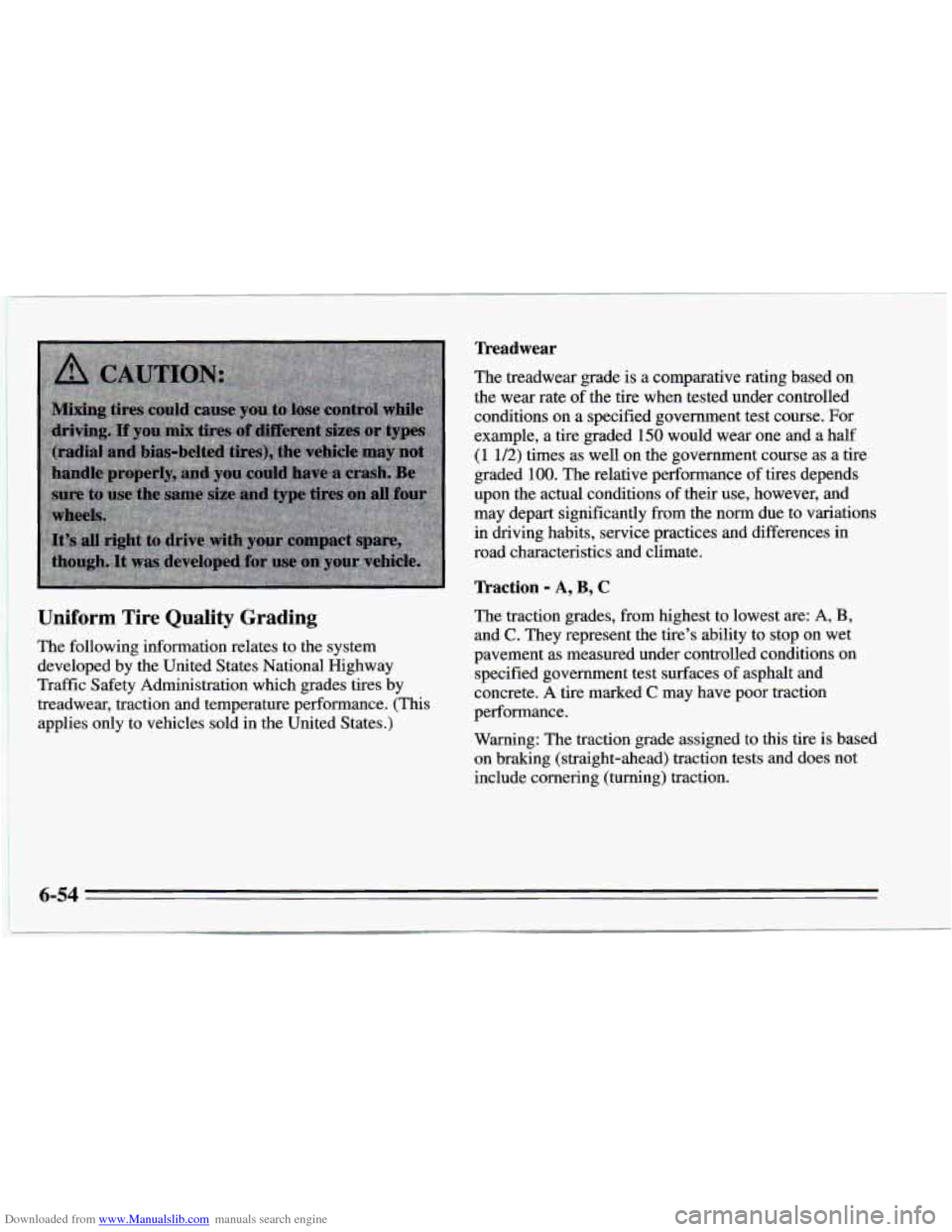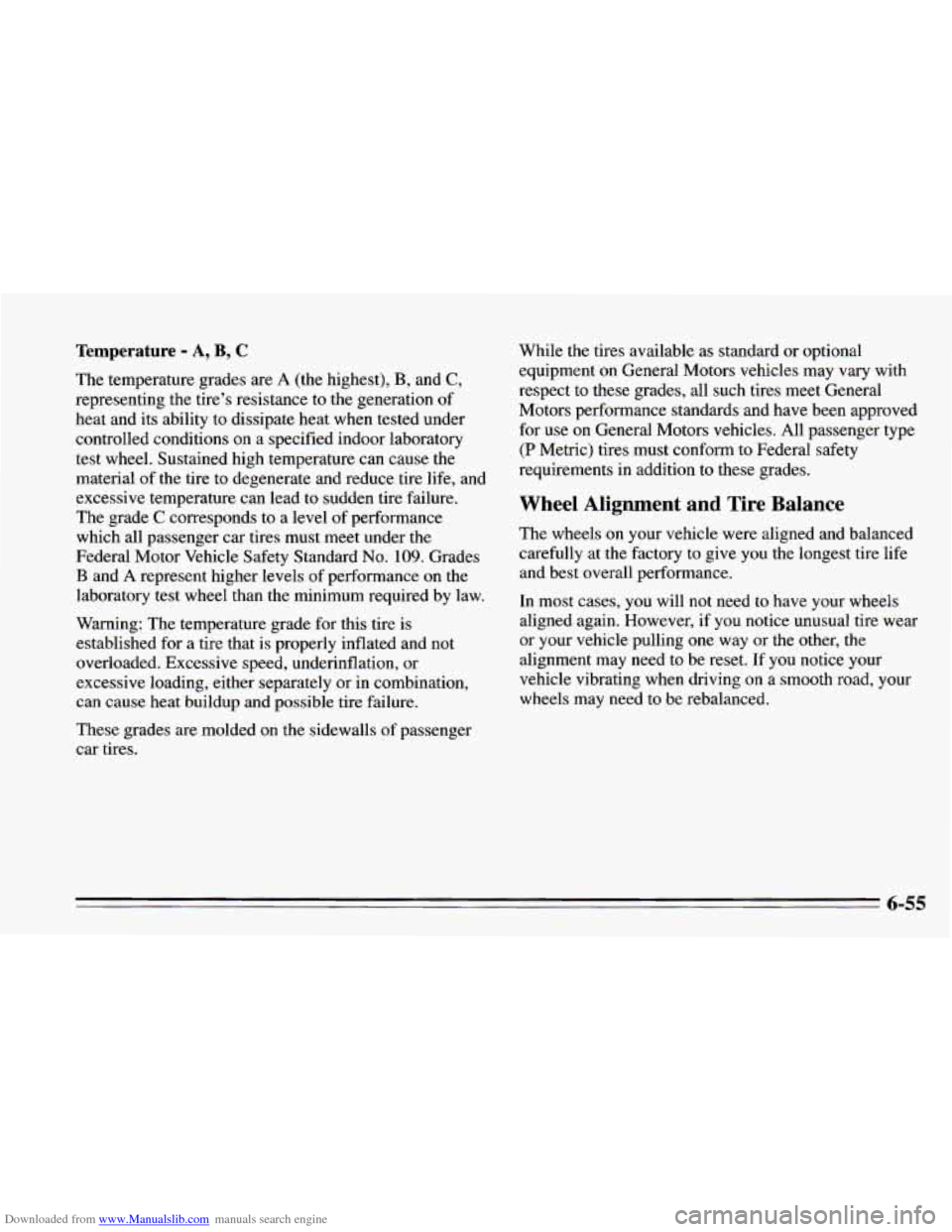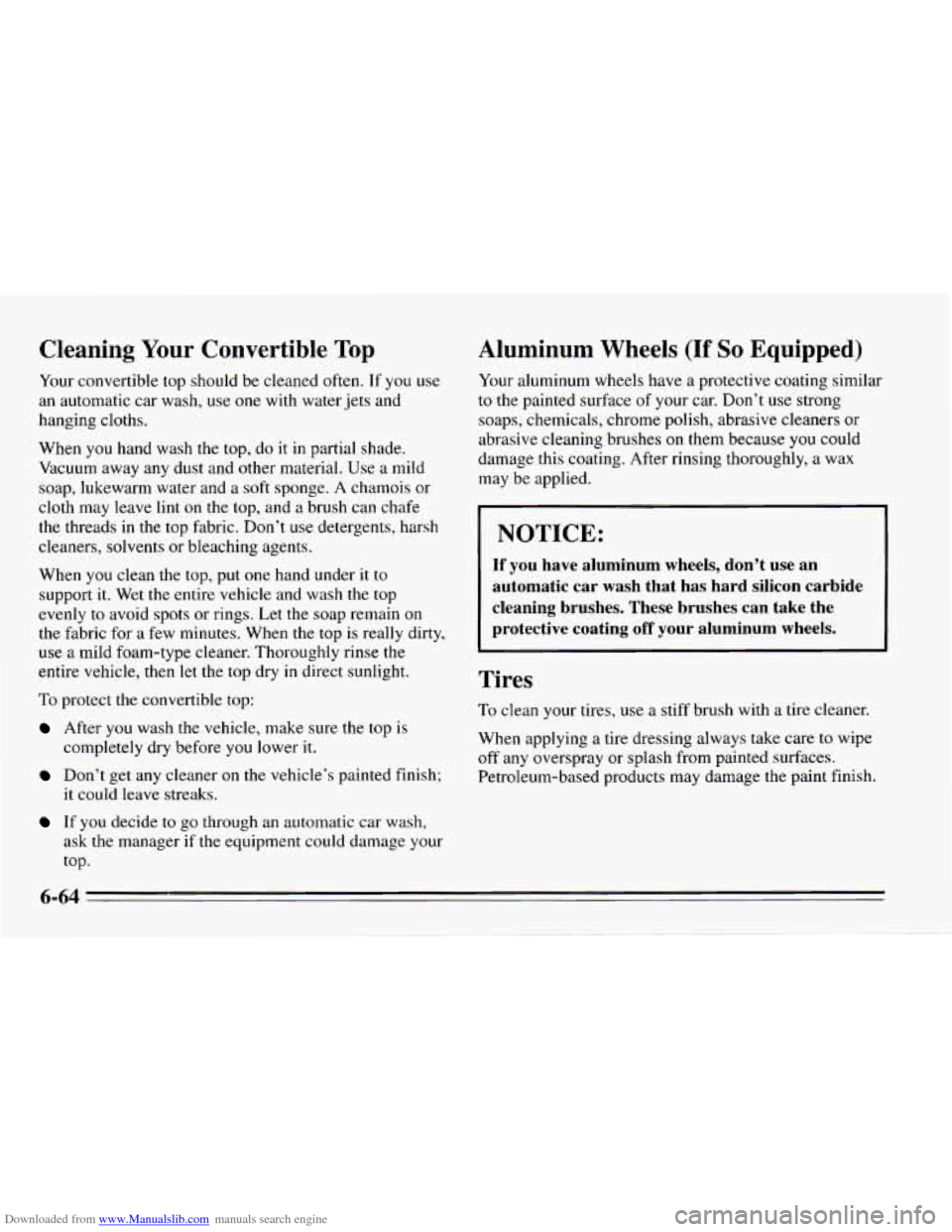Page 285 of 388

Downloaded from www.Manualslib.com manuals search engine When it’s Time for New Tires
One way to tell when it’s
time for new tires is
to
check the treadwear
indicators, which will
appear when your tires have
only 1/16 inch (1.6 mm) or
less of tread remaining.
You need a new tire
if
a
a
a
e
a
You can see the indicators at three or more places
around the tire.
You can see cord or fabric showing through the tire’s
rubber.
The tread or sidewall is cracked, cut or snagged deep
enough to show cord or fabric.
The tire has a bump, bulge or split.
The tire has
a puncture, cut, or other damage that
can’t be repaired
well because of the size or location
of
the damage.
Buying New Tires
To find out what kind and size of tires you need, look at
the Tire-Loading Information label.
The tires installed
on your vehicle when it was new had
a Tire Performance Criteria Speci€ication (TPC Spec)
number on each tire’s sidewall. When
you get new tires,
get ones with that same TPC Spec number. That way,
your vehicle will continue to have tires that are designed
to give proper endurance, handling, speed rating,
traction, ride and other things during normal service on
your vehicle.
If your tires have an all-season tread
design, the TPC number will be followed by an
“MS”
(for mud and snow).
If you ever replace your tires with those not having a
TPC Spec number, make sure they are the same size,
load range, speed rating
and construction type (bias,
bias-belted or radial) as your original tires.
6-53
Page 286 of 388

Downloaded from www.Manualslib.com manuals search engine Uniform Tire Quality Grading
I The following information relates to the system
I developed by the United States National Highway
i Traffic Safety Administration which grades tires by
~ treadwear, traction and temperature performance. (This
applies only to vehicles sold in the United States.)
Treadwear
The treadwear grade is a comparative rating based on
the wear rate
of the tire when tested under controlled
conditions on a specified government test course. For
example, a tire graded 150 would wear one and a half
(1 1/2) times as well on the government course as a tire
graded
100. The relative performance of tires depends
upon the actual conditions of their use, however, and
may depart significantly from the norm due to variations
in driving habits, service practices and differences in
road characteristics and climate.
Traction - A, B, C
The traction grades, from highest to lowest are: A, B,
and C. They represent the tire’s ability to stop on wet
pavement as measured under controlled conditions
on
specified government test surfaces of asphalt and
concrete. A tire marked
C may have poor traction
performance.
Warning: The traction grade assigned to this tire is based
on braking (straight-ahead) traction tests and does not
include cornering (turning) traction.
6-54
Page 287 of 388

Downloaded from www.Manualslib.com manuals search engine Temperature - A, B, C
The temperature grades are A (the highest), B, and C,
representing the tire’s resistance to the generation of
heat and its ability to dissipate heat when tested under
controlled conditions on a specified indoor laboratory
test wheel. Sustained high temperature can cause the
material of the tire to degenerate and reduce tire
life, and
excessive temperature can lead to sudden tire failure.
The grade
C corresponds to a level of performance
which all passenger car tires must meet under the
Federal Motor Vehicle Safety Standard
No. 109. Grades
B and A represent higher levels of performance on the
laboratory test wheel than the minimum required by law.
Warning: The temperature grade for this tire
is
established for a tire that is properly inflated and not
overloaded. Excessive speed, underinflation, or
excessive loading, either separately or in combination,
can cause heat buildup and possible tire failure.
These grades are molded
on the sidewalls of passenger
car tires. While
the tires available as standard or optional
equipment on General Motors vehicles may vary with
respect to these grades, all such tires meet General
Motors performance standards and have been approved
for use
on General Motors vehicles. All passenger type
(P Metric) tires must conform to Federal safety
requirements in addition to these grades.
Wheel Alignment and Tire Balance
The wheels on your vehicle were aligned and balanced
carefully at the factory to give you the longest tire life
and best overall performance.
In most cases, you will not
need to have your wheels
aligned again. However,
if you notice unusual tire wear
or your vehicle pulling one way or the other, the
alignment may need to be reset. If you notice your
vehicle vibrating when driving
on a smooth road, your
wheels may need to be rebalanced.
6-55
Page 289 of 388
Downloaded from www.Manualslib.com manuals search engine Used Replacement Wheels Tire Chains
NOTICE:
If your Chevrolet has P235/55R16 or
P245150ZRl6 size tires, don’t use tire chains;
they can damage your vehicle.
If you have other tires, use tire chains only where
legal and only when you must. Use only
SAE
Class “S” type chains that are the proper size for
your tires. Install them on the rear tires and
tighten them
as tightly as possible with the ends
securely fastened. Drive slowly and follow the
chain manufacturer’s instructions.
If you can
hear the chains contacting your vehicle, stop and
retighten them.
If the contact continues, slow
down until
it stops. Driving too fast or spinning
the wheels with chains on will damage your
vehicle.
6-57
Page 296 of 388

Downloaded from www.Manualslib.com manuals search engine Cleaning Your Convertible Top
Your convertible top should be cleaned often. If you use
an automatic car wash, use one with water jets and
hanging cloths.
When
you hand wash the top, do it in partial shade.
Vacuum away any dust and other material. Use a mild
soap, lukewarm water and a soft sponge.
A chamois or
cloth may leave
lint on the top, and a brush can chafe
the threads in the top fabric. Don’t use detergents, harsh
cleaners, solvents or bleaching agents.
When you clean the top, put
one hand under it to
support it. Wet the entire vehicle and wash the top
evenly to avoid spots or rings. Let
the soap remain on
the fabric for a few minutes. When the top is really dirty,
use a mild foam-type cleaner. Thoroughly rinse the
entire vehicle,
then let the top dry in direct sunlight.
To protect the convertible top:
After you wash the vehicle, make sure the top is
Don’t get any cleaner on the vehicle’s painted finish;
completely dry
before
you lower it.
it could leave streaks.
If you decide to go through an automatic car wash,
ask
the manager if the equipment could damage your
top.
Aluminum Wheels (If So Equipped)
Your aluminum wheels have a protective coating similar
to the painted surface
of your car. Don’t use strong
soaps, chemicals, chrome polish, abrasive cleaners or
abrasive cleaning brushes
on them because you could
damage this coating. After rinsing thoroughly,
a wax
may be applied.
I
I NOTICE:
If you have aluminum wheels, don’t use an
automatic car wash that has hard silicon carbide
cleaning brushes. These brushes can take the
protective coating
off your aluminum wheels.
Tires
To clean your tires, use a stiff brush with a tire cleaner.
When applying a tire dressing always take care
to wipe
off any overspray or splash from painted surfaces.
Petroleum-based products may damage
the paint finish.
6-64
Page 315 of 388
Downloaded from www.Manualslib.com manuals search engine I Maintenance Schedule I I
6,000 Miles (10 000 km)
0 Change engine oil and filter (or every
3 months, whichever occurs first).
An Emission Control Service.
0 Lubricate the steering linkage. Lubricate the transmission shift linkage (or every
6 months, whichever occurs first).
0 Rotate tires. See “Tire Inspection and
Rotation” in the Index
for proper rotation
pattern and additional information.
DATE SERVICED BY: ACTUAL MILEAGE
7,500 Miles (12 500 km)
0 Change the rear axle gear lubricant if
vehicle is used to pull a trailer or has
limited-slip differential.
DATE ACTUAL MILEAGE SERVICED BY:
7-7
Page 318 of 388
Downloaded from www.Manualslib.com manuals search engine I Maintenance Schedule I I
18,000 Miles (30 000 km)
Change engine oil and filter (or every
3 months, whichever occurs first).
An Emission Control Service.
El Lubricate the steering linkage. Lubricate the
transmission shift linkage (or every
6 months, whichever occurs first).
0 Rotate tires. See “Tire Inspection and
Rotation” in the
Index for proper rotation
pattern and additional information.
DATE
SERVICED BY: ACTUAL MILEAGE
21,000 Miles (35 000 km)
0 Change engine oil and filter (or every
3 months, whichever occurs first).
An Emission Control Service.
DATE
SERVICED BY: ACTUAL MILEAGE
7-10
Page 321 of 388

Downloaded from www.Manualslib.com manuals search engine I Maintenance Schedule I I
0 Replace spark plugs (except 5.7L Code P
0 Inspect spark plug wires. An Emission Control
0 Replace air cleaner filter. Replace filter
more often under dusty conditions.
engine).
An Emission Control
Service.
Sewice.
An Emission Control Service.
0 Inspect fuel tank, cap and lines for damage
or leaks. Inspect fuel cap gasket for any
damage. Replace parts as needed.
An Emission Control Service. -f
Cl Change automatic transmission fluid and
filter
if the vehicle is mainly driven under
one or more
of these conditions:
- In heavy city traffic where the outside
temperature regularly reaches
90 O F
(32 O C) or higher.
- In hilly or mountainous terrain.
- When doing frequent trailer towing.
- Uses such as found in taxi, police or
If you do not use your vehicle under any of
these conditions, change the fluid and filter
at
IO0,OOO miles (I 66 000 km).
Manual transmission fluid doesn’t require
change.
0 Rotate tires. See “Tire Inspection and
Rotation”
in the Index for proper rotation
pattern and additional information.
delivery service.
I DATE I ACTUAL MILEAGE ISERVICED BY: I
7-13